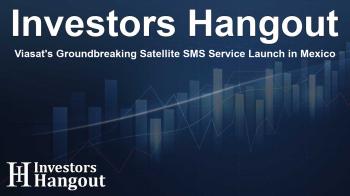Viasat's Groundbreaking Satellite SMS Service Launch in Mexico

Viasat Pioneers Satellite SMS Messaging on Android
Viasat, Inc. (NASDAQ: VSAT), a leading company in the satellite communications sector, has recently achieved a significant milestone in Mexico. The company successfully conducted a demonstration of their direct-to-device (D2D) technology, allowing Android smartphones to send and receive SMS messages via satellite. This groundbreaking event marks the first successful trial of satellite SMS messaging on Android in the country.
Transforming Communication with Satellite Technology
The demonstration featured two mass-market Android devices, one connected to Viasat’s I-4 F3 satellite and the other to a conventional cellular network. This innovative approach showcased Viasat’s ability to deliver SMS messages efficiently using 3GPP Non-Terrestrial Network (NTN) standards. The successful transaction not only verifies the capability but also highlights the potential for enhanced communication connectivity in regions where traditional services may fall short.
Leveraging Advanced Satellite Infrastructure
Viasat’s D2D technology allows everyday mobile devices to access satellite communication without requiring specialized hardware. It utilizes well-established satellite spectrum, making it feasible for mobile network operators to collaborate in future service expansions without disrupting existing terrestrial networks. This initiative represents not just an advancement for Viasat but promises a wider impact on connectivity in rural and underserved areas.
Global Applications and Previous Demonstrations
With prior successful demonstrations in India, Brazil, the Middle East, and Hawaii, Viasat’s latest trials reflect a steadfast commitment to bringing satellite-based communication to diverse markets. The current approach underscores the evolution of global communications, positioning Viasat as a pivotal player in enhancing connectivity in places where it matters most.
Viasat's Vision for the Future
Hector Rivero, General Manager of Viasat Mexico, expressed enthusiasm about the project’s potential impact across the region. He emphasized that this technology could connect millions of users in previously inaccessible areas, thus driving economic and social advancement. Viasat’s commitment to bridging the connectivity gap resonates strongly in this initiative, reflecting their vision of uniting the world through robust satellite communication capabilities.
Collaboration with Industry Leaders
Viasat's role extends beyond just providing services. As a founding member of the Mobile Satellite Services Association (MSSA), the company actively promotes mobile satellite connectivity and open architecture standards among various industry stakeholders. The collaboration with Space42, an AI-powered SpaceTech firm based in the UAE, signifies Viasat's ongoing efforts to enhance global D2D services and transition existing mobile satellite capabilities into 5G environments.
About Viasat, Inc.
Viasat is a global communications powerhouse dedicated to connecting people and devices. With operations in over 24 countries, Viasat is on a mission to provide high-quality, reliable, and secure communication networks. The company aims to make affordable and fast connections accessible to everyone, from individual consumers to governmental agencies. Recently, Viasat completed its merger with Inmarsat, which further strengthens its operational capabilities and market reach, creating a more formidable global communications partner.
Frequently Asked Questions
What is the significance of Viasat's SMS demonstration in Mexico?
This demonstration marks a breakthrough in using satellite technology for basic SMS messaging on widely available Android devices, essentially making communication accessible in previously underserved areas.
How does Viasat's D2D technology work?
The D2D technology allows smartphones to connect directly to satellites without the need for dedicated satellite hardware, leveraging existing satellite spectrum for communication.
What previous locations has Viasat demonstrated D2D technology?
Before Mexico, Viasat successfully demonstrated D2D technology in several regions, including India, Brazil, the Middle East, and Hawaii, showcasing its versatility and effectiveness.
What role does Viasat play in the Mobile Satellite Services Association?
As a founding member, Viasat promotes mobile satellite connectivity and collaborates with various industry players to advance open architecture standards in mobile satellite services.
What are Viasat’s future goals with satellite communication?
Viasat aims to enhance global connectivity, particularly in underserved regions, while evolving its technologies to adapt to new environments such as 5G, thereby transforming how mobile communication is conducted worldwide.
About The Author
Contact Dylan Bailey privately here. Or send an email with ATTN: Dylan Bailey as the subject to contact@investorshangout.com.
About Investors Hangout
Investors Hangout is a leading online stock forum for financial discussion and learning, offering a wide range of free tools and resources. It draws in traders of all levels, who exchange market knowledge, investigate trading tactics, and keep an eye on industry developments in real time. Featuring financial articles, stock message boards, quotes, charts, company profiles, and live news updates. Through cooperative learning and a wealth of informational resources, it helps users from novices creating their first portfolios to experts honing their techniques. Join Investors Hangout today: https://investorshangout.com/
The content of this article is based on factual, publicly available information and does not represent legal, financial, or investment advice. Investors Hangout does not offer financial advice, and the author is not a licensed financial advisor. Consult a qualified advisor before making any financial or investment decisions based on this article. This article should not be considered advice to purchase, sell, or hold any securities or other investments. If any of the material provided here is inaccurate, please contact us for corrections.

